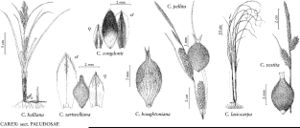Carex houghtoniana
Amer. J. Sci. Arts 30: 63, plate Bb, fig. 91. 1836.
Plants colonial; rhizomes long-creeping. Culms lateral, trigonous, 20–80(–100) cm, scabrous-angled. Leaves: basal sheaths reddish purple, bladeless, apex of inner band glabrous; ligules 1.5–14 mm; blades green, M-shaped, 2.8–8.5 mm wide, glabrous. Inflorescences 4.5–23 cm; proximal (1–)2–3(–4) spikes pistillate, ascending; distal spikes erect; terminal 1–3 spikes staminate. Pistillate scales lanceolate to ovate, apex acute to acuminate-awned, glabrous, scabrous-ciliate apically. Perigynia ascending to spreading, 16–22-veined, broadly ovoid to broadly ellipsoid, 4.5–6.5 × 2–2.9 mm, cellular details and veination clear, sparsely short-pubescent; beak 1.2–2 mm, bidentulate, teeth straight, 0.5–0.8 mm.
Phenology: Fruiting Jun–Aug.
Habitat: Dry to moist sandy or gravelly soils in open, disturbed sites, rocky balds, ledges
Elevation: 0–1000 m
Distribution

Alta., Man., N.B., Nfld. and Labr., N.S., Ont., Que., Sask., Ill., Maine, Mich., Minn., N.H., N.Y., Vt., Wis.
Discussion
Carex houghtoniana responds strongly to fire and other disturbances, appearing quickly, presumably from the seedbank, then often dying out in a few years if the disturbance is not repeated.
The epithet is often, but not originally, spelled “houghtonii.”
Selected References
None.
